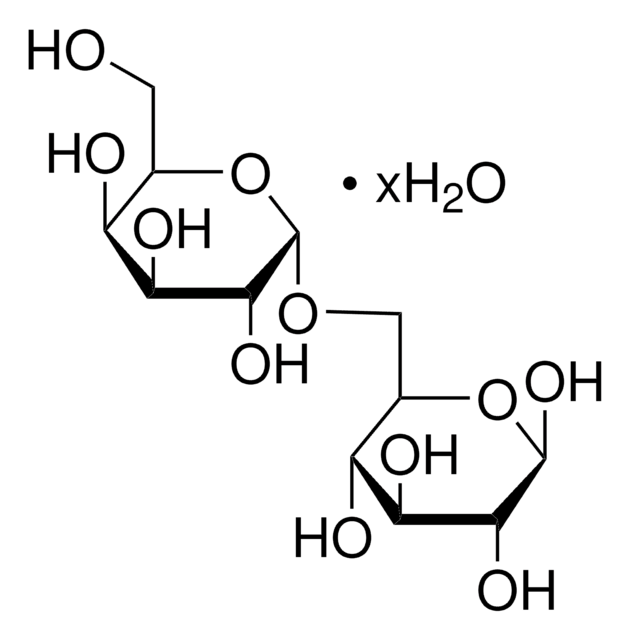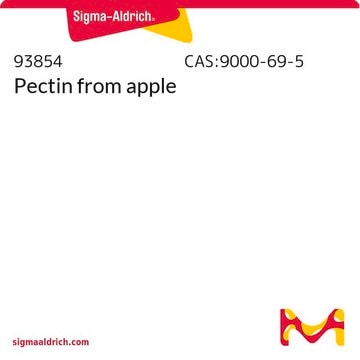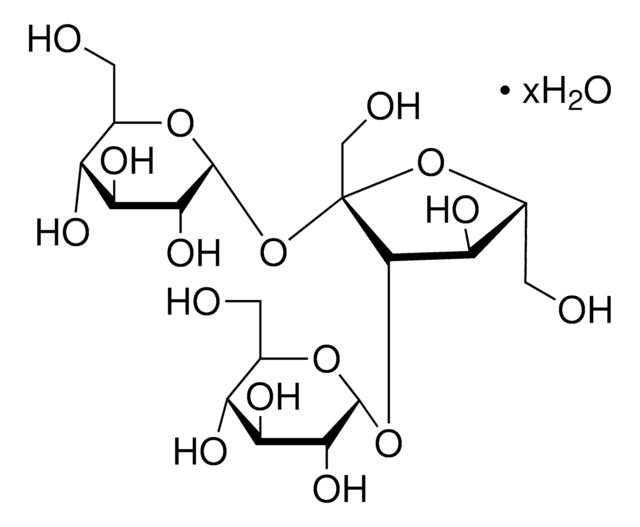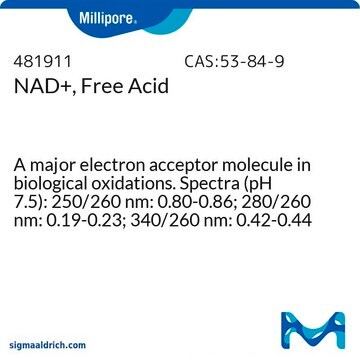63630
D-(+)-Melibiose
suitable for microbiology, ≥99.0%
Sinonimo/i:
Raffinose, Melizitose, α-D-Galactosyl-(1→6)-α-D-glucopyranoside, Galactosyl D-glucose, Galactosylglucose, D-Galactopyranosyl-(1→6)-D-glucose, Melibiose, Galactinol, D-(+)-Galactosyl-(1→6)-D-(+)-glucose, α-D-Gal(1→6)β-D-Glc, 6-O-α-D-Galactopyranosyl-D-glucose
About This Item
Prodotti consigliati
Livello qualitativo
Saggio
≥99.0% (HPLC)
≥99.0%
Forma fisica
powder
Attività ottica
[α]20/D +137±3°, 10 hr, c = 5% in H2O
Confezionamento
pkg of 10 g
pkg of 50 g
Residuo alla calcinazione
≤0.1% (as SO4)
Colore
colorless to white
Solubilità
H2O: 0.1 g/mL, clear, colorless
Anioni in tracce
chloride (Cl-): ≤50 mg/kg
sulfate (SO42-): ≤200 mg/kg
Cationi in tracce
As: ≤0.1 mg/kg
Ca: ≤500 mg/kg
Cd: ≤5 mg/kg
Co: ≤5 mg/kg
Cr: ≤5 mg/kg
Cu: ≤5 mg/kg
Fe: ≤10 mg/kg
K: ≤50 mg/kg
Mg: ≤10 mg/kg
Mn: ≤5 mg/kg
Na: ≤50 mg/kg
Ni: ≤5 mg/kg
Pb: ≤5 mg/kg
Zn: ≤5 mg/kg
applicazioni
microbiology
Stringa SMILE
OC[C@H]1O[C@H](OC[C@@H](O)[C@@H](O)[C@H](O)[C@@H](O)C=O)[C@H](O)[C@@H](O)[C@H]1O
InChI
1S/C12H22O11/c13-1-4(15)7(17)8(18)5(16)3-22-12-11(21)10(20)9(19)6(2-14)23-12/h1,4-12,14-21H,2-3H2/t4-,5+,6+,7+,8+,9-,10-,11+,12-/m0/s1
AYRXSINWFIIFAE-GFRRCQKTSA-N
Cerchi prodotti simili? Visita Guida al confronto tra prodotti
Descrizione generale
Applicazioni
Stoccaggio e stabilità
Codice della classe di stoccaggio
11 - Combustible Solids
Classe di pericolosità dell'acqua (WGK)
WGK 3
Punto d’infiammabilità (°F)
Not applicable
Punto d’infiammabilità (°C)
Not applicable
Dispositivi di protezione individuale
Eyeshields, Gloves, type N95 (US)
Choose from one of the most recent versions:
Possiedi già questo prodotto?
I documenti relativi ai prodotti acquistati recentemente sono disponibili nell’Archivio dei documenti.
I clienti hanno visto anche
Articoli
Culture media provides a habitat with suitable nutrients, energy sources, and certain environmental conditions for the growth of microorganisms. The components of the culture media range from simple sugars to peptones, salts, antibiotics, and complex indicators.
Il team dei nostri ricercatori vanta grande esperienza in tutte le aree della ricerca quali Life Science, scienza dei materiali, sintesi chimica, cromatografia, discipline analitiche, ecc..
Contatta l'Assistenza Tecnica.











